'Symonds for Kodaks',
Smiths Suitall also Alfred Coe, Sennitt's, The Lyceum, The Cross
Keys in Carr Street
12 Upper Brook Street
Let's come clean about this. Once upon a time, drivers
of vehicles could come down Northgate Street to the traffic lights at
the Great White Horse, before proceeding down Upper Brook Street. It
was while waiting at a red light some years ago that Borin Van Loon
glanced upwards and noticed this chimney stack lettering on its pale
background panel. It was, long before access to the internet (or even
the internet iself) became a possibility for 'the man in the street',
the gestation for the Ipswich Historic Lettering website. With a vague
idea that other examples in the town could be recorded, a (film)
photographic sequence was eventually begun; perhaps it could be
researched and expanded into a book? This remains a possibility, but a
website at least gives the capacity to revise, update and replace
images and information.
The buildings at the corner of Butter Market and (below)
Upper Brook
Street
have a chequered history. Before the latter road was widened in the
1930s,
J.A. Symonds' chemists shop (now an optician's premises) appeared in a
number
of period photographs. Such was the pressure on trading space in the
previous
century, it was not unknown for shops and stall holders to extend their
areas of operation into the street and over pedestrian paths. Streets,
already
narrow and crowded, became almost impassable at times. The shops on the
site shown below used to project several yards into the street.
In the 21st century it is home to one of the
most
iconic
pieces of historic trade lettering in the town. Once the shop was Brook
Craft Market, later a bakers and sandwich shop, then an old fashioned
sweet shop. All the while and for many years before, high above stood
this lettering.
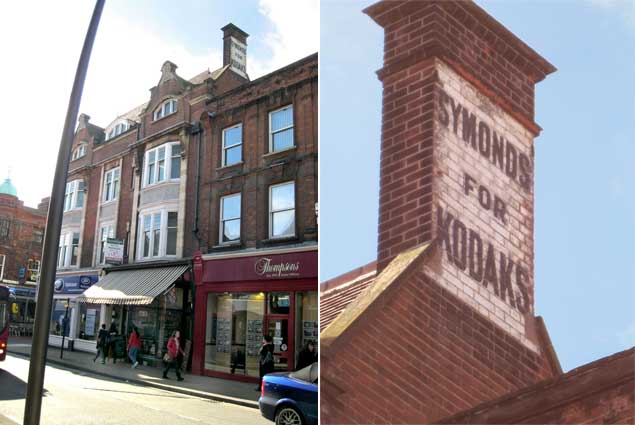 2012 images
2012 images
The phraseology of this advertisement (see below* for
an
explanation) seems at first glance rather
esoteric:
'SYMONDS
FOR
KODAKS'
It was clearly designed to catch the eye of those
approaching
further up the slope of Upper Brook and Northgate Streets. Whether this
actually
worked is debatable given the plethora of high buildings which surround
it. We hope that the signwriter involved was on danger money during the
creation
of this sign. And to prove that it's not just lettering which perches
on high on this building, take a look at the art nouveau mouding which
sits atop of the two gables facing Upper Orwell Street:

Below: an unfamiliar view from around 1900 of the top
part of Upper
Brook
Street. The viewpoint is roughly from outside the present Wilkinsons
shop
and clearly shows the original Symonds chemists shop projecting into
the
street at the junction with Buttermarket. Other contemporary
views show the shop visible along Buttermarket creating a 'nip' in that
end of the street. In the 1860s the traders around this north-west
corner of Buttermarket 'had succeeded in inducing the Local Board of Health to vote £2,000
for the piece of land to be thrown into the street'. They bought
a number of properties on the north side and replaced them with a row
of 'good-looking white and red brick houses' [R. Malster in the Reading List]. This doesn't quite tie up with
the supposed date of 1900 for the period photograph below; one assumes
that the foreshortening of the buildings on the Butter Market side
would
have been done at the same time as the projecting buildings on the
Upper Brook Street side. Perhaps it took until after 1900, when
the photo is dated, to effect the demolition and rebuild of the
'good-looking buildings' which survive to the 21st Century. The
'Symonds for Kodaks' sign therefore probably dates from the first
decade of the 1900s.
The projecting corner of the Symonds shop was once known as Pump Corner
– the site of a public water-pump.
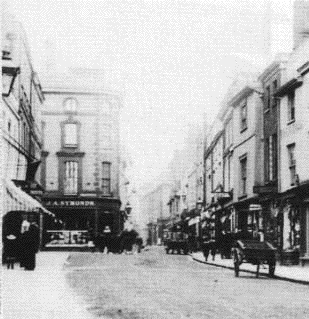 1900 image
1900 image
For an evocative photograph of most of Upper Brook
Street from the 1880s see our Old
Cattle Market page under 'Sir Thomas
Rush's house'.
Incidentally, more traces of chemist shop lettering can
be found at Hales Chemist (doorstep)
in St Helens
Street, 'E. J. Owles' in Fore Street
(frosted glass door) and in Felixstowe
Road.
The Symonds sign is opposite The Cock &
Pye public house.
[UPDATE 19.1.2014: Tony
Wooderson sends this haunting image of the legendary 'Symonds' chimney
stack.]
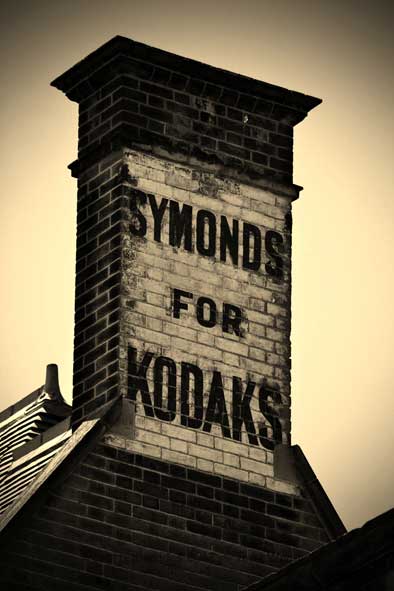 Photo
courtesy Tony Wooderson /Crafted Images (UK)
Photo
courtesy Tony Wooderson /Crafted Images (UK)
*The origins and philology of 'Kodaks'
In 1883, George Eastman startled the photographic trade with the
announcement
of film in rolls, with the roll holder adaptable to nearly every plate
camera
on the market. With the "Kodak" camera in 1888, he put down the
foundation for making photography available to everyone.
The business started as the Eastman company, but added the name of its
most
successful product, to become Eastman Kodak in 1892. Asked about the
name,
George Eastman replied, 'Philologically, the word Kodak is as
meaningless
as a child's first "goo" - terse, abrupt to the point of rudeness,
literally bitten off by firm and unyielding consonants at both ends, it
snaps like a camera shutter in your face. What more would one ask!' The
camera proved such an enormous success that the word Kodak was
incorporated
into the company name.
(The Japanese electronics company Sony gained its invented name in the
1970s
for similar reasons: short, memorable and essentially meaningless
therefore
able to be marketed without bias and adverse connotation in any
language,
in any country.)
Muriel Clegg in The way we went
(see Reading list) notes that, around 1850
when hard pavements of stone became more common in the town,
proprietors of businesses like J.A. Symonds could not resist using the
new surfaces for promotion. 'The new pavements proved to be a
temptation to advertisers. Steps had to be taken to prevent such
disfigurements as advertisements painted on the pavements by Mr Knopps
and Mr Collinson.'
14-16 Upper Brook Street research
Stevens Directory gives the
following occupants at this address:-
1881 (no. 16 only): Robert Lyon, dentist;
1885 (nos. 14-16): Robert Lyon, chemist and druggist;
1890 (no. 16): W. Ellis Cressweller, chemist;
1894 (nos. 14-16): J.A. Symonds, chemist and druggist;
by Kelly’s Directory, 1954
the entry has been expanded to: ‘J.A. Symonds Ltd, chemist, photo
finishers & photographic apparatus dealers. Tel. 3164.’
The last entry for J.A. Symonds is in Kelly’s
for 1956.
52-54 Butter Market: '1900'
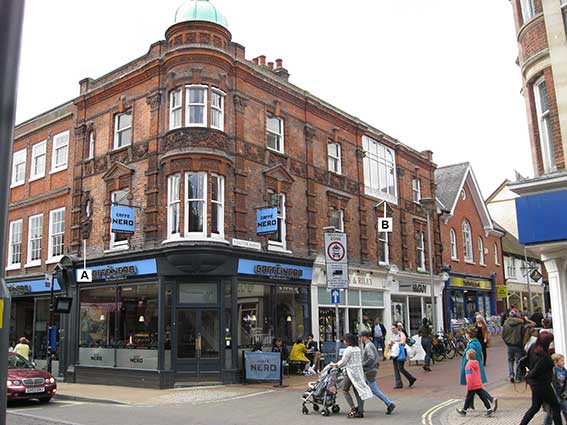 2016
image
2016
image
Over the jaws of Butter Market, a
rather florid
building
stands today with swags of terra cotta fruit and flowers, pilasters and
pedimented windows on both faces
of
the former shoe shop (now, inevitably a coffee chain), with corner
turret. In the late 1920s the corner premises were Bernard Hines sports
shop and its neighbour on Butter Market was Hudson Verity opticians.
If you want to
know the date of this particular building look at the oval window
moulding (gratifyingly, we discover that this type of fenestration is
called 'oeil de boef' – bull's eye) on Upper Brook Street (marked A
above):
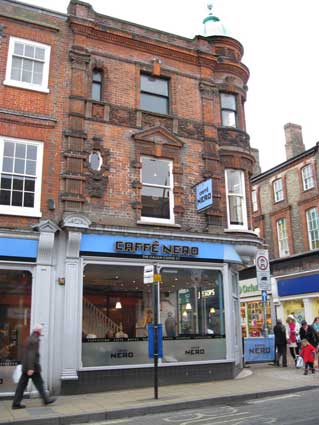
 2013 images
2013 images
'1900'
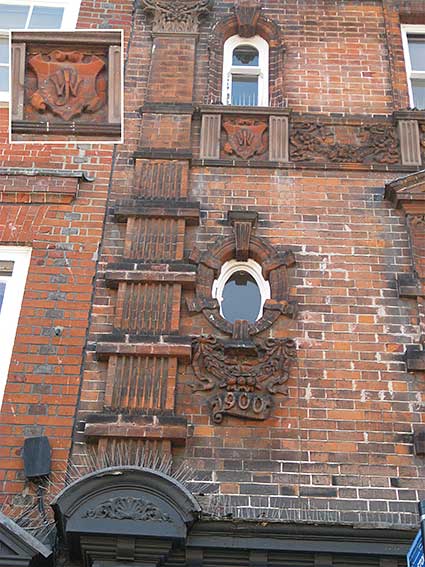 2018 image
2018 image
Looking at the larger face of the building here reveals,
above the '1900' moulding, a scrolled cartouche (inset close-up in the
white
frame at top left) bearing the initials:
'JW'
with the J over the W. This is
almost certainly the initials of the original proprietor, John White,
photographer. Scroll down for trade directory evidence.
It was in 2018 that were told of a coat of arms
in the first floor of
this '1900' corner building. We include it on our Crests
page.
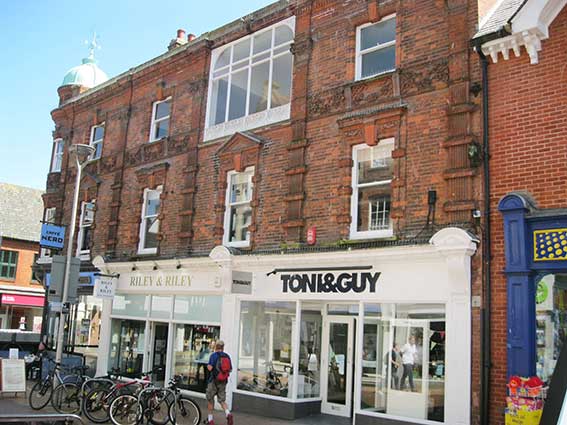 2018 image
2018 image
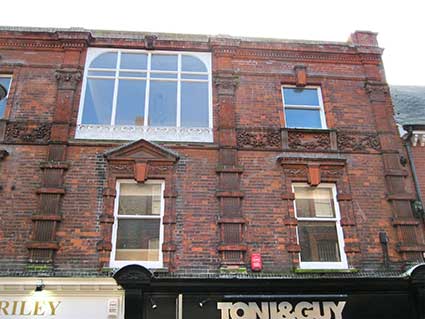
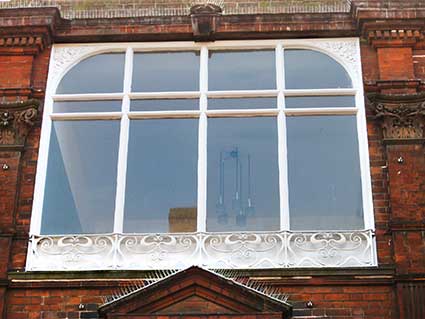 2015 images
2015 images
The elevation on Butter Market continues the interest with art nouveau
detailing on the picture window spandrels and wrought iron
'balconette' (marked B on the above first photograph). This was the
window designed specifically for a
photographer's studio; as with the whole corner
building it is the work of Eade & Johns,
local architects.
 detail
detail
Below is a photograph of the Butter Market shops from the 1940s/1950s
(?), with that window, here with the detailing painted black, at top
left.
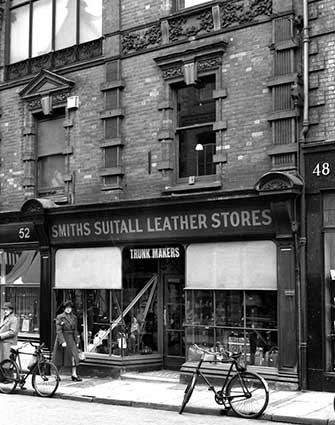 1940s/50s?
image
1940s/50s?
image
Smiths Suitall
The shop at no. 50 Butter Market carries the signs: SMITHS SUITALL
LEATHER STORES, TRUNK MAKERS'. In fact, in an earlier incarnation at
this address, 'Messra Smith', was a noted outlet for Harbutt's
Plasticine (as advertised in our 1902
Guide to Ipswich). So, leather trunks and Plasticine, then. Such a
range of goods requires us to repeat the Grace's guide (see Links) entry:-
' "Smiths, Suitall, Ipswich". (1922) Ditto Address. Telephone: Ipswich
2304. (1929)
▪ 1922 Listed Exhibitor - British
Industries Fair. Fancy Cloth and Leather Goods, including Frames.
Autograph Albums, Attaché, Music, Suit and Writing Cases and Travelling
Goods; Printers; Bookbinders. (Stand No. L.7)
▪ 1929 Listed Exhibitor - British
Industries Fair. Manufacturers of Leather Suit Cases, Attaché Cases,
Kit, Gladstone, Brief and Square Bags, Trunks, School Bags, Music
Cases, Golf Bowls [sic],
Tennis and Cartridge Bags, Gun Cases, Hat Boxes, Hockey Bags. (Stand
No. P.69)'
The shop was described (perhaps referring to the 1950s) as 'a small
department store which specialised in stationery items'. In fact, the company 'Smiths, Suitall
Limited' is
still listed as having been formed in 1940 (though now 'Dormant'),
having an address in Claydon. We would love to include an
advertisement for the shop here.
Smiths Suitall in the trade directories
Stevens Directory 1881 Butter Market [from the
junction with Upper Brook Street]:
[no number] Smith Walter A. photographer;
50 Conder T.E. & J. leather merchants;
[N.B.: 40 Phillips and Piper woollen drapers &c.].
Stevens Directory 1885
52 White John photographer;
50 Conder T.E. and J. leather merchants;
46 and 48 Smith W. cash stationery warehouse;
[N.B. 40 Phillips and Piper woollen drapers; also: 'Pawsey & Hayes
booksellers, stationers, printers & bookbinders, The Ancient House;
-here is Stephen's lane-'].
Stevens Directory 1894
46 & 48 Smith (S.) & Smith stationery warehouse;
50 Conder T.E. & J. leather mers;
52 White John photographer.
Kelly's
Directory 1909
52 White & Son photographers.
Kelly's Directory 1934
no photographer listed.
Kelly's Directory 1952
46, 48 & 50 SMITHS, SUITALL LTD. printers, stationers,
bookbinders, & travelling requisites;
52 Verity L. Hudson F.B.O.A. ophthalmic optician;
24 Hilton S. & Sons Ltd. boot mkrs.
The selected entries from trade directories contain several points of
interest:-
- Firstly, the fact that Smiths Suitall Ltd were
late to the premises in Butter Market, not appearing in directories
until 1952.
However, the name Smith appears in this location as early as 1881
(photographer) and 1894 (stationery warehouse). One can, perhaps,
assume that this is the same Smith family of Smiths Suitall. A
contemporary description of the business: '... a small department store
which specialised in stationery items. It was opposite Hunt’s builders
merchants. When they left the Butter Market, the Bandbox opened up on
the site, it was a pub that opened with extended hours. Later it became
a shop again'. (The Bandbox at 46-48 Butter Market is thought to date
from 1973, but it was on the site of an older beerhouse, called the
Buttermarket Tavern.)
- The date of '1900' on the Upper Brook Street
elevation of the current corner building indicates that it replaced
earlier businesses which would have been in timber-framed and plastered
buildings, probably projecting further into the road. Road-widening in
both streets resulted in rebuilt facades, as shown on the Symonds
building (above). The use of the
large, upper window with the decorative balconette as a photographic
studio is indicated by the 1909 entry for no. 52 Butter
Market: [John] 'White &
Son photographers'.
- The 'JW' monogram appearing above the date
therefore refers to John White, who must have been prospering as a
photographer to have the large, decorative facade erected. This
appears to be the last mention of photographers here, so the large
windowed studio room would have been used by other businesses,
eventually to become part of Smiths Suitall Ltd.
Tangential issues along the way through the trade
directory entries:-
- The slightly unexpected 'Phillips & Piper
woollen drapers' shop at no. 40 Butter Market in 1881 and 1885. This
company is better known as clothing manufacturers, particularly of
sportswear
at their large Christchurch Works between St Margarets Street and Old
Foundry Road
as shown on our E. Brand & Sons page.
A 1936 advertisement for Phillips & Piper on that web-page advertises 'Tailored Clothes' and
'Riding Breeches' indicating, perhaps, the link to the original drapery
business.
- The well-remembered curriers and
leather-cutters, T.E. & J. Conder
had premises in various locations in Ipswich (Tanners Lane,
Silent Street, Turret Lane, and Fore Street) including 50 Butter Market
(1881 to 1894 directories in our selected list above) and were known in particular for supplying leather
for horse tack. The company traded under the name 'T.E. & J. Conder ' since 1862
and is believed to have been in family hands since 1765. One wonders if
the stocking of leather luggage (note the 'TRUNK MAKERS' sign in the
monochrome photograph, above) and accoutrements by Smiths Suitall
was influenced by the previous proprietors of No. 50 Butter Market.
- Smiths Suitall were listed as 'printers, stationers, bookbinders' in 1952, so it is
interesting to note the proximity of, perhaps one of the best-known
printers in Butter Market (apart from W.S. Cowell whose shops were in
Butter Market, but whose large printing business was in the
now-disappeared Market Lane), Pawsey
& Hayes in The Ancient House (1885 entry). Prints, postcards
and small-circulation publications can still be found for sale on
internet sites and elsewhere, no doubt. ['Ancient House Press' was
established in 1845 as a book-selling and printing business. After a
period of time the book-selling and printing businesses were separated
and the latter moved to larger premises in the town. The company was
started by Mr. Frederick Pawsey, a well-known local figure in printing
circles, who sold the business in 1897 to the Harrison family, who
retained ownership until 1971. Many will remember the Ancient House as
a large bookshop.]
- The presence at no. 24 Butter Market of 'Hilton S. & Sons Ltd.
boot mkrs.' (1952) reminds us of another well-remembered shop
close to Smiths Suitall at no. 44: Alderton's shoe shop / A. Jones
& Sons which became Jones the Bootmaker in 1972. It relocated after
the disastrous fire of August 1992 and returned, eventually to close
down in August 2017.
The Butter Market fire
A major event which could have threatened The
Ancient House
was a disastrous
fire in nearby timber-framed buildings in August 1992. Booksale
remainder shop (now
'The Works'), Alderton's shoe shop (later Jones the Bootmaker) and
Hughes TV & Audio (where the
electrical fire started) were all
destroyed, robbing Ipswich of some important timber-framed buildings.
The intense heat melted plastic
guttering on buildings across the road and we recall picking up bits of
ash from the garden driven away from the fire by the westerly wind.
Incidentally, the former ABC
cinema had already been demolished in 1988, so the gap might have acted
as a fire-break protecting The Ancient House if the wind had been in
another direction. The old Waggon &
Horses tavern (opened in the 16th century and closed in 1935 (see our Ipswich
Museum page for the original pub sign) preceded the cinema and
adjoined The Ancient House. The Rex Cinema opened on the site on
the 1st
January 1937. It was renamed the ABC in 1962 when, presumaby the
modernist frontage was installed. After the 1992 fire all the above
premises
were
rebuilt and reoccupied by The Works and Jones the Bootmaker (although
Hughes stayed in their new home in Tower Ramparts
Shopping Centre and have since relocated) and British Home Stores took
over the
space which runs
right round from Butter Market to the rear of The Ancient House.
This included the unsuccessful pedestrian mall with a series of small shop units either side stretching
from the Butter Market (street) through to Arras Square. In September
1993 Ipswich was coupled (not quite 'twinned' as the
Borough reputedly didn't want to pay the official twinning fee...) with
Arras,
France and the area
behind the house is now called Arras Square (see our Blue plaques page).
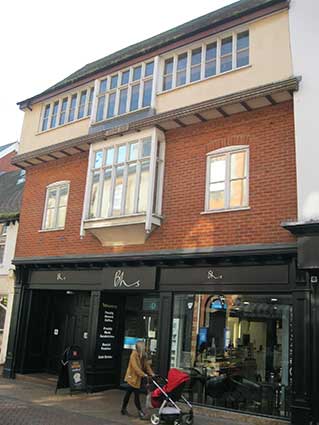
 2018
images
2018
images
Above: 42 Butter Market (no. 40 is just visible
to the right) shows the first
building to be constructed from the east end of the street, adjoining
the former Jones The Bootmaker shop (Listed Grade II). An interesting
nod to the 16th
century building it replaced: double-jettied, with – between the
second storey between the
decorative oriel window below – a dated 'bressumer' on the jetty reads '1994
AD'. This is the date of the rebuild. The next building westwards
(no. 40) is plainer, however it is Listed Grade II. The modern shop
facade disguises the fact that it is the westerly half of a large 16th
century house – its large central chimney-stack can still be seen
between numbers 40 and 42. No. 40 has timber framing and features saved
from the fire in August 1992. The next feature is the one-time
entrance to the failed 'mall/shopping arcade' (later subsumed into the
BHS
store), then a collonaded and jettied building – the site which was
once ABC cinema which abutts
The Ancient House. All of these, nos. 32 to 42 Butter Market became the
British Home Stores
department store which closed in August 2016.
See also our Ancient House page for
further images and information about this intriguing street.
18 Carr Street (Sennitt's)
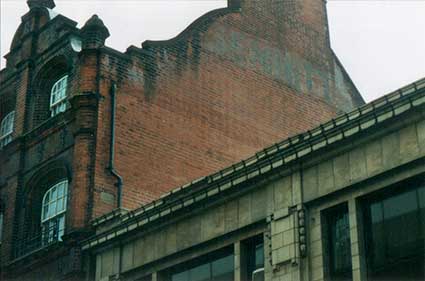 2001
images
2001
images
Round the corner from the former Symonds and to the
right in Carr
Street,
we
find another lost trading name from Ipswich's past emblazoned on a
high,
curving gable:
'SENNITT'S'
sits above
the present
shop occupied by the
butchers,
Meat-Inn. Probably the subject of unsuccessful brick cleaning
operations,
the capitals are now grey and indistinct, but very big.
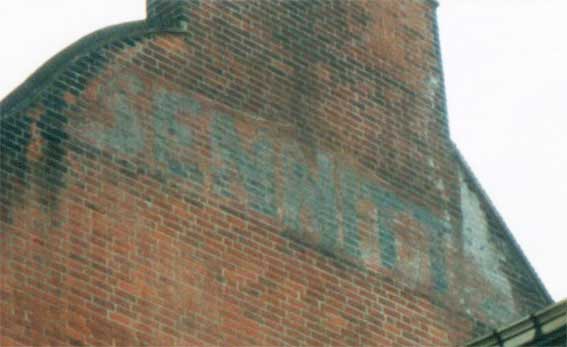
This close-up taken in 2011 is ghostly (the final
'apostrophe S' less
distinct). An 1890s photograph of Upper Brook Street taken from the
White Horse Corner shows a row of shops
on the east side of the road
running down to the Cock & Pye
public house (one of the few
buildings still standing in modern times. The shop just before the pub
is Sennitt's shop selling teas. It seems quite possible that when these
buildings were demolished Sennitt's moved round the corner to premises
in Carr Street. Hence the giant lettering.
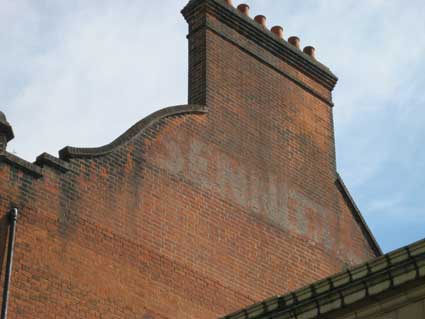 2011 image
2011 image
The Listing Grade II text: 'Shop and offices. 1888. By T.W. Cotman [see
also Lloyds Bank and the Crown & Anchor]. For
Mr Scheurmann. Red brick laid in Flemish bond. Machine-tiled roof.
Flemish style, the gable-end facing the street. 4 storeys in 3-window
range. Narrow facade. Late C20 plate-glass shop front with marble
pilasters
right and left supporting cast-iron railings. First floor with one
semicircular window right and left each fitted with two 2/2 horned
sashes. Between them is a moulded arched recess containing a French
window with glazing bars and margin lights. Upper 2 floors bisected by
a flat pilaster and bordered by one polygonal colonnette right and left
of elevation. Second floor with two 8/8 horned sashes set within
separate moulded arched recesses and fronted by cast-iron railings.
Third floor with 2 similar windows. Elaborate shaped gable with finial.
Gabled roof. Large internal gable-end stack to west. (Brown C, Haward
B, Kindred B: Dictionary of
Architects of
Suffolk Buildings 1800-1914: Ipswich: 1991-: 86).'
[UPDATE 22.12.2013: Richie
Wisbey's Flickr site has a nice collection of period photographs and we
chanced upon this rare image of the Sennitt's shop in Carr Street,
probably in the 1920s. It is so much smaller an establishment than the
size of the ghost sign above might suggest – and it's a grocery shop
('Provision .. SENNITT'S .. Stores'), not the department store or
furnishers we imagined. Thanks to Richie for permission to include it
here.]
 Image
courtesy Richie Wisbey
Image
courtesy Richie Wisbey 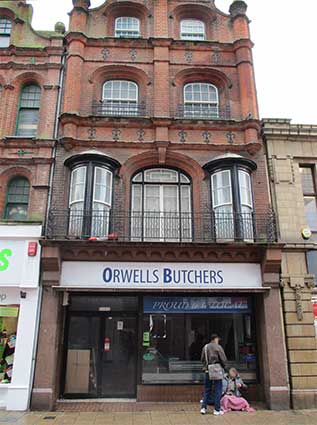 2023
image
2023
image
Above: the Sennitt's shop in c.1920s and the view in January 2023.
18 (& 20) Carr Street
research
From 1881 to 1903 (sample entries) these addresses were occupied by
W.J. Topham, watchmaker; George Sheuermann, butcher & ham and bacon
curer; The Danish Dairy Co., John Chadbourne, manager.
Kelly’s Directory 1918: first
listing of 'Sennitts, provsn. mers'; Sennitts had gone by the 1940 Kelly’s.
N.B. (at no. 18): by 1956 Sunnocks Ltd, outfitters; by 1947, 'Mac
Fisheries Ltd, fishmongers'.
6/8 Carr Street
Next door to the Sennitt's lettering is a Subway fast food shop. Here
Carr Street has a much
smaller trade sign, brought to our attention by Mike O'Donovan (who must have a very keen eye, not to mention a good zoom
camera
lens). It is
so high up and so unremarkable, it's not surprising that this went
unnoticed for so long.
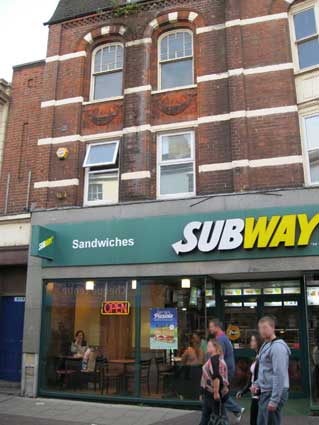 2013 image
2013 image
Beneath
the redbrick swags and the reversed 'S' stretcher point (to the right
of the open window in the above photograph) is the metal
plate affixed by the company which constructed the building.
'ALFRED COE
BUILDER IPSWICH'
It's a humble little advertisement, but has certainly
stood the test of
time. Anyone any idea when Alfred Coe was running his business in the
town? [See UPDATE below.]
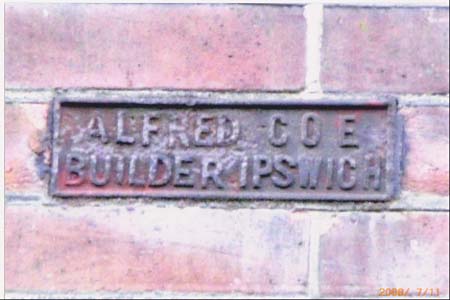 [Photograph courtesy Mike
O'Donovan]
[Photograph courtesy Mike
O'Donovan]
[UPDATE 31.8.2013: "Hi Borin,
Very enjoyable & educational site. I see that you have asked for
info about Alfred Coe Builder. Please find attached page from Kelly's
1883. In the 1888 edition he is is listed at the Brooks Hall Rd
Address. In the 1900 edition he is listed in Crown Street. Kind
Regards, Brian Warner". Many thanks
to Brian for the information. We have resisted the temptation to
reproduce the Kelly's listing in case of copyright problems; but we
note
that Alfred Coe must have been doing quite well in 1883 as there is
mention of
premises in both "Brooks Hall road & Tacket street". Perhaps this tiny, rusted panel in Carr
Street is the only remaining physical evidence of this Ipswich builder.]
[UPDATE: 28.11.2022: Tim
Leggett spotted a piece of stencilled lettering referring to one of
several important Ipswich foundries which was revealed on this building
for only a short time. First, we see the 'before and after', then the
load-bearing girder labelled 'COCKSEDGE & CO.'.
 2022
images courtesy Tim Leggett
2022
images courtesy Tim Leggett
It is interestng that Cocksedge had to add their name by spray paint
and stencil (a tradition continued today by Banksy). In the old days of
cast iron girders, the letters would have been part of the casting. We
assume that this beam was extruded, so no chance of lettering. There
are only a few traces of Cocksedge & Co.lettering found so far in
Ipswich: see Garden gates & railings,
a bollard on the Dockside at
ground-level, and a Milestone at
Kesgrave. In October 2022, the building here which was once a Subway
food outlet, but which closed for some years following a fire, was
quickly renamed, the interior refitted and the 'I Love Noodle' fast
food restaurant opened for business. Thanks
to Tim for sending the photographs.]
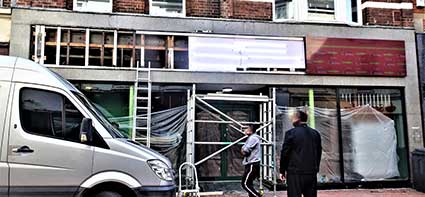
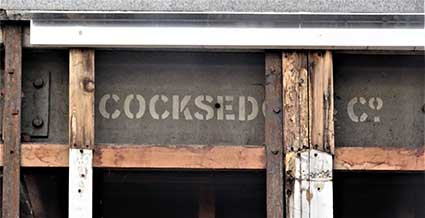
The upper part of the building, bears at its apex, the date '1888'
with the characteristic eights with flattened tops seen on the E. Brand & Sons building.
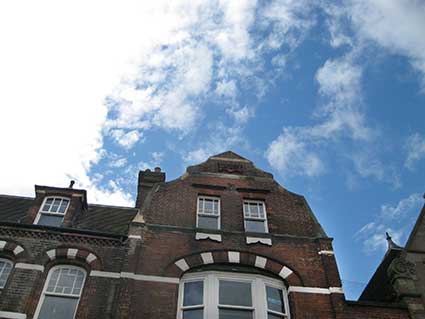
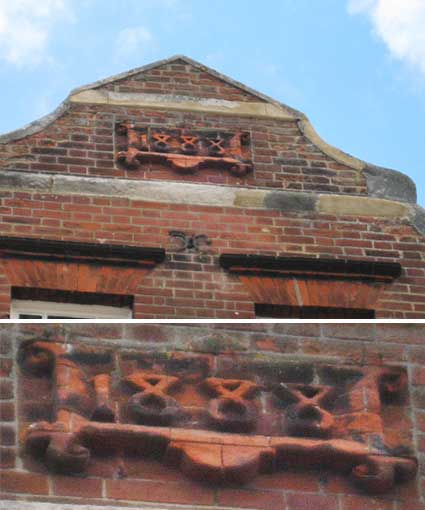 2016 images
2016 images
1-3a Carr Street, Santander offices
 2023 image
2023 image
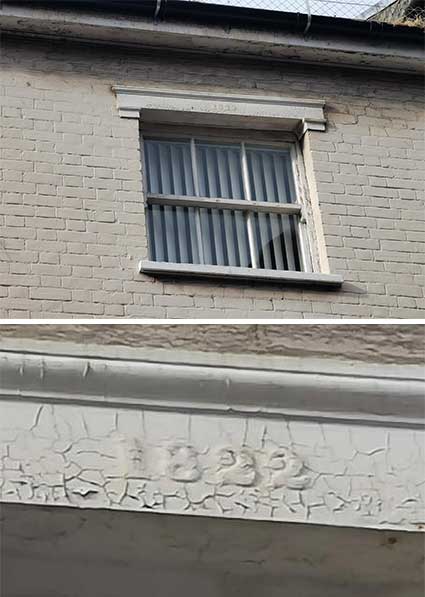 2022
image courtesy Tony Cross
2022
image courtesy Tony Cross
[Update 7.5.2022: 'I
recently noticed this 1822
date plaque while gazing out of the window of Costa in Carr Street. It
is the on top floor of the Santander building. Tony Cross.' Thanks to Tony for spotting this high up
on the second storey window lintel – not the centre one, but the one on
the top right. It's an undistinguished building with, perhaps, a
surprisingly early date of 1822, which is placed almost out of sight.]
1-3 Carr Street research
From 1881 to 1903 (sample entries) these addresses were occupied by
R.E. Younger, chemist, oil and colour warehouseman; M.A. Ling, toy and
fancy dealer; Mrs S. Hill, registry office for servants; Southgate
& Co., accountants; Edward Aldous, hatter & hosier; H.C. Hill,
fancy repository; Wm Slack, confectioner; Levy Bros, clothiers. More
research is required as to when the Abbey National Building Society
knocked the premises into one branch.
The Lyceum Theatre

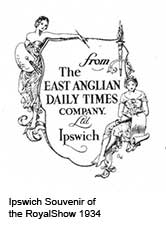
The hand-tinted postcard c.1905, above, shows The Great White Horse
Hotel in the background, behind the tram. On the right, by the turreted
building is the entrance to the long-gone Little Colman Street. That
building, although not built for the company, was the home of the East Anglian Daily Times (founded
1874) stable of newspapers from 1887, eventually moving to the Lower
Brook Street offices. The Lyceum Theatre (opened 1891, but converted to
a department store in 1936) is on the right with the hanging lamps ove
the entrance. Demolition of these rather fine buildings in 1966 led to
the modernist shopping centre 'Carr Precinct' which never really found
a place in
the hearts of Ipswichians.
See our Harold Hulcupp Withers page
for a 1932 advertisement for the EADT.
For a view of this area from outside Croydon's
in the 1930s, see our Tavern Street
page.
The Cross Keys Inn,
24/26 Carr Street
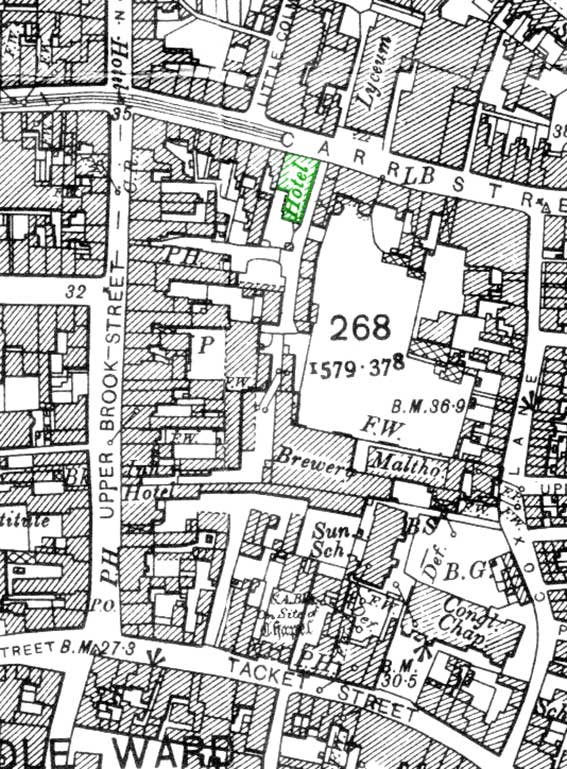 1902
map
1902
map
As so often, the excellent online CAMRA Suffolk Real Ale Guide
(see Links) is helpful. The Cross Keys Inn
stood across Carr Street from The Lyceum
Theatre and was listed in the 1844 White's
Suffolk Trades Directory with carriers operating from it to
Colchester.
Carr Street was for a time known as 'Cross Keys Street' after this inn
(see Street name derivations under
'Carr Street'.).
The original timber-framed building was extensively rebuilt when the
street was widened (circa 1887-88) to allow double-tracking for trams
to pass. The
radical changes were wrought by the Carr Street Improvement Company,
formed in 1887 to buy up old properties and demolish or alter them to
allow
street-widening. Cross Keys Lane is the lane that goes from Carr St to
the rear of what was known as Woolworth's
car park; on the 1902 map above the lane meets up with the rear
access to the Cock & Pye public
house (marked 'P.H.') on Upper Brook Street. The Cross Keys Inn finally
closed in 1938.
Like The Cock & Pye, The Cross Keys. it was one of several pubs in the town that used to host
cock-fighting in eighteenth and early nineteenth century. This bloody
spectacle could last several hours and was eventually banned in 1835. A
one time it was particularly popular as a form of gambling and bouts
were often held during festival days and during the Ipswich horse
racing week.
"To be lett, and enter'd into immediately, the Cross-Keys Inn, in
Cross-keys street, Ipswich. A well accustom'd House with a Brewhouse,
Cellars, Good Stables, Water and other suitable Conveniences; where may
be bought Coppers, Coolers and all other Utensils for Brewing of five
Combs at a Time, ready fixed; with the Stock of Beer, Household Goods,
of the late Tenant, deceased. Inquire at the said Inn, or of Messrs
Trotmans Senior or Junior in Ipswich." Ipswich Journal, March 8th 1740.
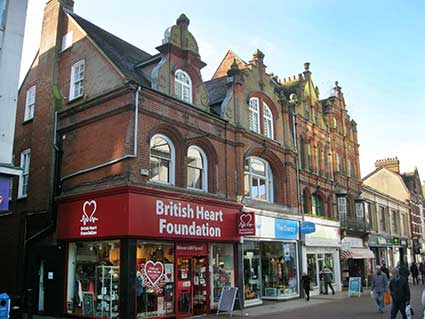 2018 image
2018 image
The Cross Keys Inn may have been at number 22 Carr
Street; but it was listed as 26-28 Carr Street in the 1909 Rates book
[from Suffolk CAMRA, see Links]. It was
situated
where a charity shop now stands at number
24 with the alleyway leading south, visible at the far left (image
above). The
Cross Keys was a very ancient public house; opened before 1650, it closed in 1938 (date from the Lost
pubs project, see Links.). Furthermore, it
stood in a
very ancient street (see Street name
derivations for possible sources of the name 'Carr Street'), the
site of production of many 'Ipswich
ware' pots going all the
way back to the 7th century.
You can find more Carr Street lettering on our Co-op page. See also Harold Hulcupp Withers'
connection to Carr Street.
For more on buildings in Butter Market, see our Ancient House and Giles
pages.
See also our Lettered castings
index page.
Home
Please email any comments and contributions by clicking here.
Search Ipswich
Historic Lettering
©2004 Copyright
throughout the Ipswich
Historic Lettering site: Borin Van Loon
No reproduction of text or images without express written permission

 2012 images
2012 images
 1900 image
1900 image Photo
courtesy Tony Wooderson /Crafted Images (UK)
Photo
courtesy Tony Wooderson /Crafted Images (UK) 2016
image
2016
image
 2013 images
2013 images 2018 image
2018 image 2018 image
2018 image

 2015 images
2015 images detail
detail 1940s/50s?
image
1940s/50s?
image
 2018
images
2018
images 2001
images
2001
images
 2011 image
2011 image Image
courtesy Richie Wisbey
Image
courtesy Richie Wisbey  2023
image
2023
image 2013 image
2013 image [Photograph courtesy Mike
O'Donovan]
[Photograph courtesy Mike
O'Donovan] 2022
images courtesy Tim Leggett
2022
images courtesy Tim Leggett


 2016 images
2016 images 2023 image
2023 image 2022
image courtesy Tony Cross
2022
image courtesy Tony Cross

 1902
map
1902
map 2018 image
2018 image